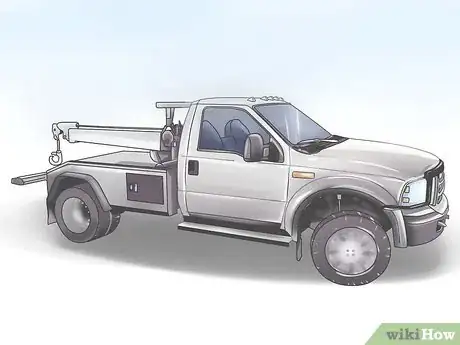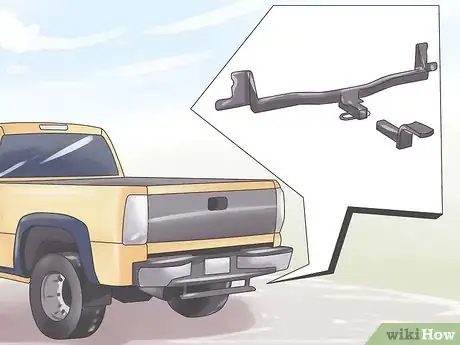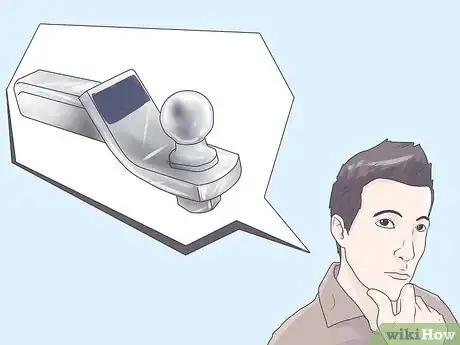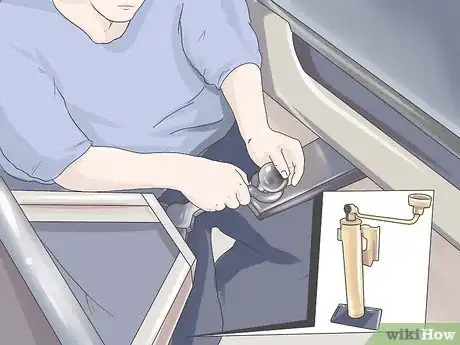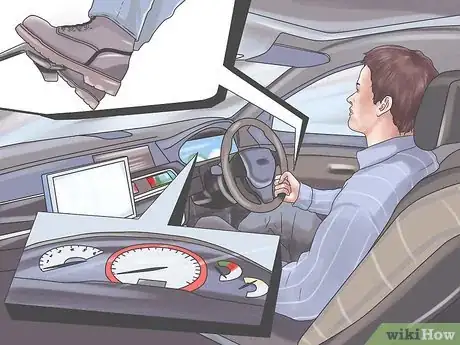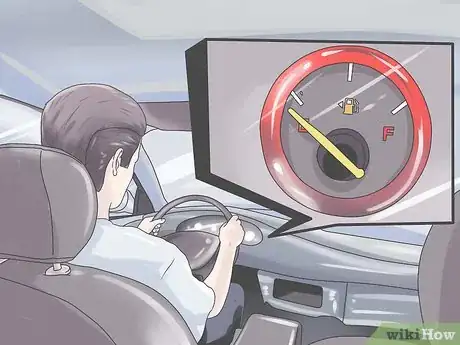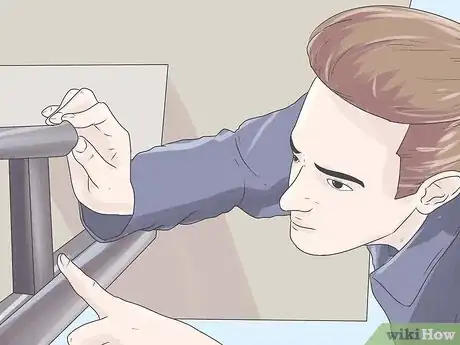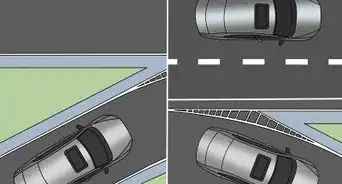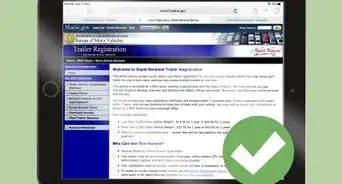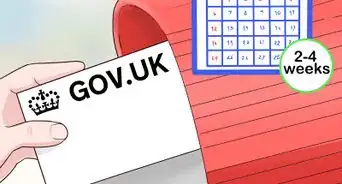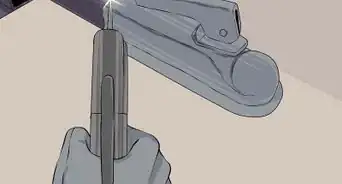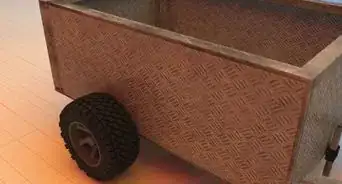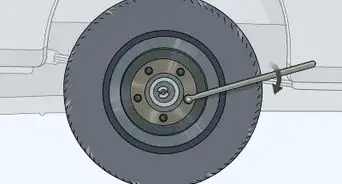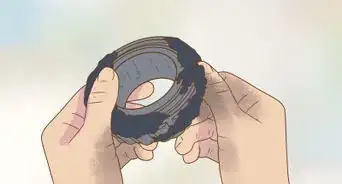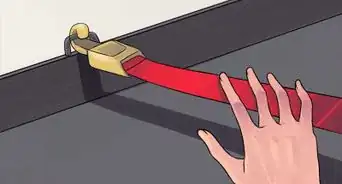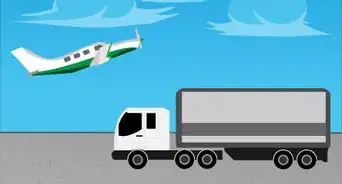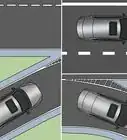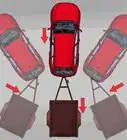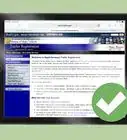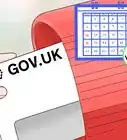This article was co-authored by Bruce Storrs. Bruce Storrs is a Driving Instructor and the President & CEO of North County School of Driving in San Marcos, California. With more than 31 years of experience, he specializes in teaching teens and adults safe driving behaviors in the classroom, online, and behind the wheel. Bruce earned a BA and MA from San Diego State University.
There are 14 references cited in this article, which can be found at the bottom of the page.
This article has been viewed 148,224 times.
Borrowing your friend's boat for a weekend at the lake sounds like a great idea until you realize you've got to drive it there. Whether you're hooking up a camper, a vehicle, or another variety of trailers to your car, learning the specifications and the techniques for doing so will make your job a whole lot easier. Learn to hitch your trailer properly, drive it correctly, and back it up safely. Federal law requires you to have a CDL Class A to tow a trailer of more than 10,000 pounds resulting in the total combined weight of the truck and trailer being more than 26,000 pounds, but if you are towing a house trailer, then you are exempt from needing a CDL.
Steps
Hitching Your Trailer
-
1Make sure your vehicle is rated for towing the load.[1] You probably can't tow an 8,000-pound full-size camper trailer with a Honda Civic. Depending upon the particular trailer you need to haul, you need to check to determine the weight limits in the owner's manual and determine the appropriate hitch to have installed.
- The weight should be generally specified by the manufacturer and listed in the owner's manual. Look online if you're missing the manual, or check at an auto shop.
- You need to find two numbers, the gross trailer weight (GTW), which is the combined weight of the trailer and the gear on it, and the maximum tongue weight for your vehicle to determine the class of hitch you'll need to tow the load.
-
2Get the appropriate class of hitch for your load installed. Generally, you'll get a hitch receiver installed that you can use for different size trailer hitches, for class 3 and up. These receivers include a removable draw-bar that you can use to install different sized hitches for different loads you might use.[2] If you get the largest receiver installed on your vehicle, you'll be ready for any sized load your vehicle can handle, classified according to the following specs:[3]
- Class 1: 2000 pounds GTW/200 pounds tongue weight
- Class 2: 3500 pounds GTW/350 pounds tongue weight
- Class 3: 5000 pounds GTW/500 pounds tongue weight
- Class 4: 7500 pounds GTW/750 pounds tongue weight
- Class 5: 10,000 pounds GTW/1000 pounds tongue weight
Advertisement -
3Get the right-sized ball for the trailer. The larger the ball, the more weight it can carry. Basically, the ball of the hitch will come in one of three sizes:[4]
- 1 7⁄8 inch (4.8 cm)
- 2 inch (5.1 cm)
- 2 5⁄16 inch (5.9 cm)
-
4Attach the trailer to the vehicle.[5] Use the tongue jack to raise the trailer and align it with the ball. Make sure that the hitch lock is unlocked before lowering the trailer onto the ball and securing the tongue. Cross the safety chains to the hooks near the vehicle hitch or the vehicle frame, making sure there is enough slack in the chains but not so much that they drag on the ground.
- Using the tongue jack, try to raise the tongue off of the ball. If you are able to do this, the ball and tongue sizes do not match, or the ball is not locked properly. In this case, replace the ball with the correct size, or lock it properly and try again.
- Once the tongue of the trailer is on the ball, you can lock it in place by placing a bolt or padlock through the ball lock mechanism to prevent it from accidentally opening.
-
5Attach the lights with the wiring harness. Generally, these employ a simple color-coded connection that makes it easy to hook up the lights to the harness should make it easy to install the connector properly to the tow vehicle's harness.[6]
- After you've hooked up the lights, do a quick brake check to make sure everything is functioning properly. It's critical to make sure that your turn signals and brakes work on the back of the trailer to ensure a safe trip (as well as no traffic tickets).[7]
- To keep the connection from corroding, you might consider spraying the contacts with a small amount of dielectric grease.
-
6Check the tongue weight. You want the amount of weight resting on the hitch to be roughly 10 to 12 percent of the total weight of the trailer.[8] You can use a regular bathroom scale to place under the beam to check.
- If the weight out-weighs your scale (which is likely for 4000 lb. and up trailers) place the scale farther up the trailer to get a smaller measurement. If you go a third of the way up, triple the weight on the scale to get the approximate weight.
- Depending on the weight of the trailer, you might consider using an equalizing bar to even out the pressure on the hitch. These are generally long metal brackets that transfer a bit of the weight more toward your vehicle's front axle. If you're hauling at the upper end of the specs, use an equalizer.
-
7Secure your load.[9] Depending on the load you're hauling, you might need to use a tarp to secure loose objects in boats or refuse trailers since you're responsible for anything that flies out and causes damage.
Driving
-
1Get familiar with the clearance of your new rig. Before you hit the road, get out your tape measure. Does the trailer make your rig considerably taller? By how much? How much length is added to the back of your car or truck? These will be important considerations any time you're trying to park somewhere you normally wouldn't give a second thought to squeezing into.
- If it's your first time towing a trailer,[12] it's best to practice some in a big empty parking lot before taking it out on the road. You want to be as familiar as possible with the vehicle's response time and turning radius.
-
2Accelerate and brake slowly. You must always compensate for the extra weight, especially when slowing down, and especially when driving on inclines. Play it safe and be cautious. You also need to pay especially close attention to the added length of your rig anytime you're:
- Changing lanes
- Merging
- Exiting the interstate
- Parking
- Stopping for gas
- Pulling over
-
3Prepare for the difference in fuel economy. Towing a significant amount of weight will negatively affect your fuel economy, so keep a close eye on the gauge. Making frequent pull-offs in crowded gas stations can be stressful for first-time towers, so try to anticipate your fuel needs ahead of time to avoid difficult maneuvers.
-
4Stop frequently and check the connection. Even if you checked and doubled checked your connections and everything is up to code, there's always the possibility that something in the road will jostle the trailer lose a bit. It's best to stop sometimes, especially on long or especially bumpy trips, to make sure everything's still hooked up. Seeing your trailer careen off the road isn't the time to double-check.[13]
-
5Stay calm if you take a turn too narrowly.[14] It'll probably happen eventually that you'll mis-time a turn, or lack sufficient space to clear a turn like you figured you would. Don't panic. Make sure there isn't traffic behind you and back up slowly and as straight as possible to give yourself the clearance you need. Get a passenger to hop out and watch the trailer from a different angle to give you steering tips, and use your mirrors judiciously.
- Readjust your mirrors so that you can see the back of your trailer.
Backing Up
-
1Get ready. No lie: backing up a trailer is one of the most difficult driving maneuvers there is, but it's easy to master with the right technique and a bit of smarts. To get ready, roll down your windows and kick a passenger out to act as a spotter. It might take a few runs before you get it perfect, so it helps to have another set of eyes.
-
2Set yourself up for success by getting perpendicular. To get yourself oriented properly, pull more or less straight perpendicular to where you want the back end of the trailer to go, keeping the truck and the trailer straight. Pull past the spot by 8–10 feet (2.4–3.0 m) to give yourself adequate room to back up.
- When you've got it lined up, turn your wheel opposite the direction of the parking spot. So, in other words, if you've pulled up perpendicular to a spot on your passenger side, enough ahead of the spot to back up, stop the car and jack the wheel to the left, or the driver's side.
-
3Learn the "S" turn.[15] Basically, to get the back end of the trailer to go right, you need to make your car back up going left and then straighten it back out to avoid a jackknife. Start backing up slowly and quickly straighten the wheel back out by turning it back toward the right. Watch your back end closely and straighten it back out if your angle gets too sharp. This'll take some practice.[16]
- Go extremely slowly. If you're in an automatic transmission, the idling speed should be plenty fast to make you nervous. Use gas only sparingly and don't make unnecessary or fast changes.
- Avoid jackknifing. If, at any point, the angle of the truck to the trailer becomes smaller than a right angle, straight it back out and give it another go. Don't try to force it, because it won't work.
-
4Don't neglect your front end. Make friends with your side mirrors so you can keep an eye on where your front end is at all times, taking special caution to watch out for parking obstacles and bumps that might mess up your approach and be a problem when you're trying to straighten back out. Drive like a pro and use your side mirrors.
- Your rear-view will be basically useless in the task. Use the help of a spotter and your side-mirrors to back up correctly.
Expert Q&A
-
QuestionWhat is the safest and easiest way to back up with a trailer?
 Bruce StorrsBruce Storrs is a Driving Instructor and the President & CEO of North County School of Driving in San Marcos, California. With more than 31 years of experience, he specializes in teaching teens and adults safe driving behaviors in the classroom, online, and behind the wheel. Bruce earned a BA and MA from San Diego State University.
Bruce StorrsBruce Storrs is a Driving Instructor and the President & CEO of North County School of Driving in San Marcos, California. With more than 31 years of experience, he specializes in teaching teens and adults safe driving behaviors in the classroom, online, and behind the wheel. Bruce earned a BA and MA from San Diego State University.
Driving Instructor Ideally, you have someone that can help you. Otherwise, get out to see where it is and adjust your mirrors. Back up very slowly and begin to turn your wheel in. If possible, do get out of the car from time to time to make sure you have the proper position. Then, continue backing up until it is safe to stop.
Ideally, you have someone that can help you. Otherwise, get out to see where it is and adjust your mirrors. Back up very slowly and begin to turn your wheel in. If possible, do get out of the car from time to time to make sure you have the proper position. Then, continue backing up until it is safe to stop. -
QuestionIs 3,000 rpm too much while towing with my Chevy Traverse?
 Community AnswerNo, half to 2/3 of your redline is the sweet spot. Just make sure to turn off overdrive.
Community AnswerNo, half to 2/3 of your redline is the sweet spot. Just make sure to turn off overdrive. -
QuestionHow do I find trailer friendly gas stations?
 Community AnswerNo way to find them but for the most part any gas station on a highway is friendly with trailers, depending on space for a trailer.
Community AnswerNo way to find them but for the most part any gas station on a highway is friendly with trailers, depending on space for a trailer.
Warnings
- Never try to pull a trailer that is too heavy for your vehicle.⧼thumbs_response⧽
References
- ↑ https://axleadvisor.com/towing-capacity/
- ↑ http://www.popularmechanics.com/cars/how-to/repair/the-right-way-to-tow-a-trailer
- ↑ https://www.popularmechanics.com/cars/how-to/a6791/the-right-way-to-tow-a-trailer/
- ↑ https://www.etrailer.com/faq-hitch-ball.aspx
- ↑ https://driving-tests.org/beginner-drivers/how-to-attach-a-trailer/
- ↑ https://www.carid.com/articles/connect-your-car-lights-to-your-trailer-lights-easy-way.html
- ↑ http://www.dmv.org/how-to-guides/pulling-trailer.php#Pretrip-Check
- ↑ https://www.etrailer.com/faq-how-to-determine-trailer-tongue-weight.aspx
- ↑ https://www.fmcsa.dot.gov/regulations/cargo-securement/cargo-securement-rules
- ↑ https://www.popularmechanics.com/cars/how-to/a6791/the-right-way-to-tow-a-trailer/
- ↑ https://www.etrailer.com/faq-ballmount.aspx
- ↑ https://driving-tests.org/beginner-drivers/how-to-drive-with-a-trailer/
- ↑ http://www.edmunds.com/how-to/how-to-tow-a-trailer.html
- ↑ https://driving-tests.org/beginner-drivers/how-to-drive-with-a-trailer/
- ↑ https://www.livinlightly.com/how-to-backup-a-travel-trailer-like-a-pro/
- ↑ http://www.artofmanliness.com/2012/02/06/how-to-back-up-a-trailer-like-a-man/
About This Article
To tow a trailer, use the tongue jack to raise the trailer and align it with the ball. Unlock the hitch lock, then lower the trailer onto the ball and secure the tongue. Cross the safety chains to the hooks near the vehicle hitch, making sure there is enough slack in the chains but not so much that they drag on the ground. Lock the hitch with a bolt or padlock, then attach the lights with the wiring harness. Once you’ve secured your load, you’re ready to drive! For tips on driving and backing up with your trailer, keep reading!
